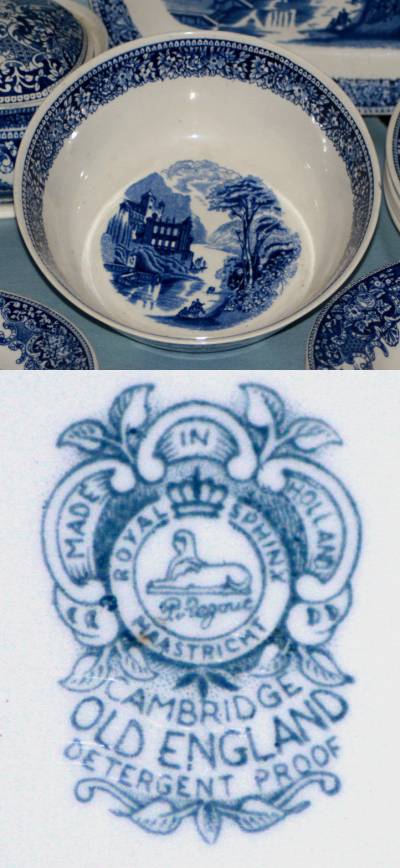
Dutch tableware. Blue and white transfer ware by Royal Sphinx, Petrus Regout, Maastricht. Ca 1910-20.
Glass and pottery factory established 1836 in Maastricht by Petrus Regout Sr. (1801-1878). One of the most important Dutch tableware producers from the latter half of the 19th century until World War II. In 1899 the company, until then known under the name of Petrus Regout, was renamed 'Sphinx'. By then, the company had already been using the image of a recumbent sphinx as its logo for twenty years. In 1913, the peak year of the Maastricht potteries, they employed about 7000 people. This number comprised almost 70% of the town's total industrial employment. In the following period the companies ran into difficulties, finally resulting in a number of mergers after the Second World War. The most important of these was the merger of Sphinx and Société Céramique de Maestricht in 1958. Sphinx stopped production of tableware in 1969.
During early 20th century Regout seems to have produced blue and white porcelain copying Chinese and Japanese products. The pieces are hard to tell apart from Japanese transfer printed porcelain from the same period but is mostly properly marked. One of the known patterns imitating Kangxi by Regout is called Peterselie (Parsley) in Dutch.
In 1851 Winand Nicolaas Clermont and Charles Chainaye founded a pottery in the Maastricht neighbourhood Wijck. Their company was taken over in 1859 by the Belgian engineer Guillaume Lambert and 1863 renamed to Société Céramique. Main competitor of Petrus Regout's firm, which was renamed Sphinx in 1899. Both Sphinx and Société Céramique produced mainly earthenware.
While most Maastricht potteries products was white and undecorated some was from the very beginning decorated by hand. The handpainting was mostly done done by women and girls using stamps for repeted patterns and a paint brush for flowers and fine borders. Their leaf and floral 'boerenbont' patterns that initially was copied from English and German potteries eventually grew with own designs to some five or six hundred, each coming in various colour variants.
Around 1840 printed decoration was introduced in Maastricht, to peak in quality as well as quantity by the end of the 19th century.
The two other important ceramics factories in Maastricht was Mosa, started in 1883 in Maastricht, the Netherlands by Louis Regout and Son, and Société Céramique. Apart from imitation Chinese plates and vases they made nice Art Nouveau and Art Deco ware. Apart from this Mosa also produces tiles.
A